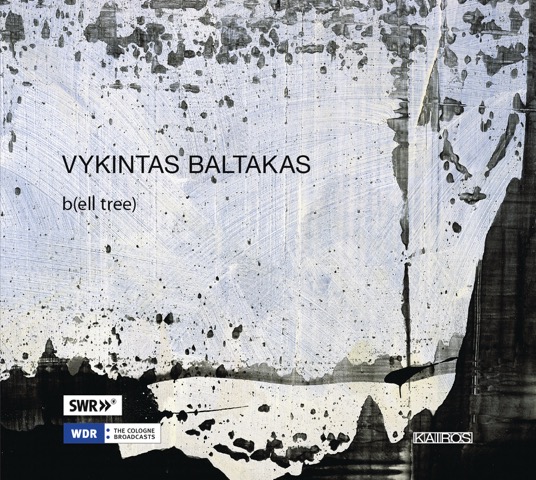“….I cannot claim to have discovered Vykintas Baltakas (born 1972): he was recommended to UE by various contact. This maverick Lithuanian, a pupil of Wolfgang Rihm and Peter Eotvos, speaks a musical language all his own. It has a primal force, informed to a certain extent by the folk-music tradition in which he grew up, a refreshing unpredictability, and an acute sense of timbre. Vykintas is proud, sensitive, and vulnerable, his blue eyes can sometimes look at you with unsettling sharpness; his mind, his thinking have a great deal of intriguing surprise in store for you…”.
Bàlint Andràs Varga on V. Baltakas, From Boulanger to Stockhausen, Rochester Press 2013.
Certainly Varga was right, at least regarding the artistic quality of Baltakas. The monograph that Kairos is dedicating to Baltakas is eloquent about the fact that within’ the Austro-German contemporary music system there was never a lost interest in developing (and finding) a surreal perfection of writing music and of all compositional activities, with a frantic search to find novelty in score: from Cerha to Rihm, from Haas to Staud, the highlight was the emergence of a strong representation of the creators of reworking, a reorganization (with or without the necessary combinatorial calculus) of all the necessary elements of music, in a land that has effectively led the musical history for a long time with multiple generations of composers in search of that specific, objective artistic qualification. Baltakas, in his move to Karlsruhe and Berlin, has also contextualized this need and happily avoided plagiarism that many composers suffer in their compositional activity, placing before him a private conceptual writing that finally has a chance to be recorded in support.
In addition to analysis carried out on timbres, in Baltakas we notice a frequent melodic minimal installation that has a morphology unique to him: few notes bruised, distorted, fragmented or serialized, which keep their rhythmic and harmonic status throughout the execution. This prerogative is essential for orchestral composition, where it achieves its maximum potential, which here is reached by (co) ro (na), Sinfonia, Saxordionphonics and especially Poussla, 18 minutes where the repetition seems to want to intercede, in the full acquiescence to contemporary writing, to Reich’s phasing technique; they’are suspensive effects falling into what Baltakas called non-linear dramaturgy, ie without information on its purpose or results, only a differentiated perspective of the aural perception of sounds. They are also invasive effects that are recomposed in a way that Baltakas outlined conceptually well, working on metaphorical figures as serpents/dragons Ouroboros invoked in his cycle of compositions: the reptile, after tail docking, reiterates a circular shape, a benefit that involves the score of e(bell) for string quartet, completely distracted from an exhausting maintenance of the trend.
We recognize the geographical origins of Baltakas in the two versions of Pasaka, where a fragmented spiritual Hindu text on the origins of creation is recited in Lithuanian, his original language, accompanied by a piano solo or with electronics: Pasaka is captivating from the philosophical point of view but it pursues a more traditional dramaturgic vision, that outshines the prevailing style used in the normal evolution of his musical writing.
_________________________________________________________________________IT_
“….I cannot claim to have discovered Vykintas Baltakas (born 1972): he was recommended to UE by various contact. This maverick Lithuanian, a pupil of Wolfgang Rihm and Peter Eotvos, speaks a musical language all his own. It has a primal force, informed to a certain extent by the folk-music tradition in which he grew up, a refreshing unpredictability, and an acute sense of timbre. Vykintas is proud, sensitive, and vulnerable, his blue eyes can sometimes look at you with unsettling sharpness; his mind, his thinking have a great deal of intriguing surprise in store for you…”.
Bàlint Andràs Varga a proposito di V. Baltakas, da From Boulanger to Stockhausen, Rochester Press 2013.
E di certo Varga non si sbagliava, almeno sulle qualità artistiche. La monografia che la Kairos dedica a Baltakas è eloquente riguardo al fatto che nel sistema musicale contemporaneo austro-tedesco non sia mai perso di vista l’interesse nel sviluppare una surreale perfezione della scrittura e delle attività compositive con una ricerca spasmodica della novità da trovare nella partitura: da Cerha a Rihm, da Haas a Staud, l’evidenza è stata l’emersione di una forte rappresentanza di ideatori della rielaborazione, un riassetto (con o senza un necessario calcolo combinatorio) di tutti gli elementi necessari della musica, in una terra che ha di fatto guidato la storia musicale per molto tempo con plurime generazioni di compositori in cerca di quella specifica, oggettiva qualificazione artistica. Baltakas, nel suo spostamento a Karlsruhe e Berlino, ha contestualizzato anch’egli questa esigenza e fortunatamente ha evitato il plagio che molti compositori subiscono nella loro attività compositiva, mettendo davanti a sé un privato concetto di scrittura che finalmente ha la possibilità di essere incisa su supporto. Oltre all’indagine sui timbri in Baltakas è evidente e frequente un impianto minimale melodico che ha una morfologia solo a lui ascrivibile: poche note acciaccate, distorte, frammentate o serializzate, che mantengono il loro status ritmico ed armonico per tutta l’esecuzione; tale prerogativa è essenziale per la composizione orchestrale, dove esprime il suo massimo potenziale, che qui viene colpita tramite (co)ro(na), Sinfonia, Saxordionphonics e soprattutto Poussla, 18 minuti dove la ripetizione sembra voler agganciare, nella piena accondiscendenza alla scrittura contemporanea, il phasing di Reich; sono effetti sospensivi che rientrano in quello che Baltakas ha chiamato drammaturgia non lineare, ossia senza indicazioni sui suoi scopi o risultati, nella sola prospettiva differenziata dalla percezione aurale dei suoni. Sono anche effetti invasivi che si ricompongono in una maniera che Baltakas ha delineato concettualmente bene lavorando su figure metaforiche come i serpenti/dragoni Ouroboros invocati in suo ciclo di composizioni: il rettile, dopo il taglio della coda, ripropone una forma circolare, un beneficio che coinvolge la partitura di e(bell) per quartetto d’archi, completamente distratta dal faticoso mantenimento della tendenza.
Le origini geografiche di Baltakas si presentano nelle due versioni di Pasaka, dove un frammentato testo spirituale Hindu sulle origini del creato viene recitato in lingua originale lituana, accompagnato da un piano in solo o con dell’elettronica: accattivante dal punto di vista filosofico, persegue una visione drammaturgica più tradizionale che mette in ombra lo stile prevalente usato nelle normali evoluzioni della sua scrittura.







